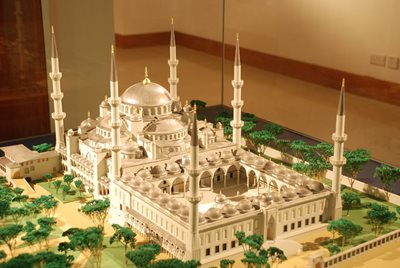

The first Sharjah Islamic Museum opened its doors in the Heritage Area in 1996. Its extensive collections were moved to the impressive building of the traditional Souq Al Majarrah to be reinterpreted and redisplayed. The new Sharjah Museum of Islamic Civilization was opened on June 6, 2008.

The Sharjah Museum of Islamic Civilization holds thousands of rare and important Islamic artifacts, Here; you can admire the timeless achievements of Islamic civilization and its universality, learn about aspects of Islamic faith, science, discoveries and culture, and cherish the beauty of Islamic art.
Admire the beauty of more than five thousand historical artifacts representative of Islamic civilization The museum comprises seven spacious galleries and display areas for its permanent collection organized as follows:
The Abu Bakr Gallery of Islamic Faith The Abu Bakr Gallery of Islamic Faith presents an introduction to Islam and the Holy Quran. It presents the five pillars of Islam, important principles of Islamic doctrine and a fascinating account of the Hajj or Islamic pilgrimage. Outstanding artifacts include monumental sections from the Kiswah, which covers the Ka’aba in Makkah, rare historical Quran manuscripts as well as models, photographs, presentations and important facts about mosque architecture from around the world.
The Ibn Al-Haytham Gallery of Science and Technology This Gallery showcases the achievements of Islamic science and the contributions of great Islamic scholars to world civilization. Sophisticated three-dimensional models, audiovisuals and extensive information panels chart some of the most outstanding discoveries, inventions and theories developed by Islamic scholars in such fields as astronomy, medicine, geography, architecture, mathematics, chemistry, military technology, marine navigation and engineering.
Islamic Art Gallery 1 This gallery shows a wide range of artefacts such as pottery, metalwork, woodcarving, manuscripts and textiles, made in the Islamic world between the 1st century AH (7th century AD) and the 7th century AH (13th century AD).
This early period marked the expansion of Islamic civilization and culture from the Arabian peninsula to the Atlantic in the West and the borders of China in the East. In the process, the material cultures of the ancient Hellenistic and Persian worlds were absorbed and transformed in line with the aesthetic, cultural and religious tastes of the new Islamic powers. Gradually, a new style emerged, characterized by an emphasis on Arab-Islamic scripts as well as geometric and floral decoration.
Islamic Art Gallery 2 This gallery displays important Islamic artworks dating from the 7th century AH / 13th century AD to the 13th century AH / 19th century AD.
Among the objects displayed are those that date back to the days following the Mongol invasion of the eastern Islamic world in the 13th century. The gallery also presents a wide selection of fascinating objects coming from Ottoman, Safavid and Mughal lands, representing an era in which the Islamic world was characterized by three powerful and competing Empires, based on and around the Mediterranean, Iran and South Asia. It was also a period of increasing global trade, economic growth and fruitful, creative interaction between artistic, cultural and indeed religious communities.
Islamic Art Galleries 3-4 These galleries are devoted to showcasing Islamic arts, crafts and weapons used between the 13th century AH / 19th century AD and 14th century AH / 20th century AD.
This period is characterized by the increasing influx of European ideas and products. Traditional markets, artisans and craftsmen now had serious competition from cheap, mass-produced goods brought in from the West. Local arts and crafts were increasingly produced for tourists, which led to changes in their style and quality. Traditional weapons continued to be popular among local populations and tourists alike. Now, they were used less in battle, but in ceremonial parades, as part of a man’s formal costume, as honorable gifts to dignitaries or indeed as collectible artefacts in their own right.
Islamic Coins Display The museum’s outstanding early Islamic coin collections are displayed in the atrium outside the Al Majarrah Gallery.
The Al Majarrah Temporary Exhibition Gallery In this gallery, the museum hosts temporary exhibitions of international standing twice a year.
Highlights from the collection